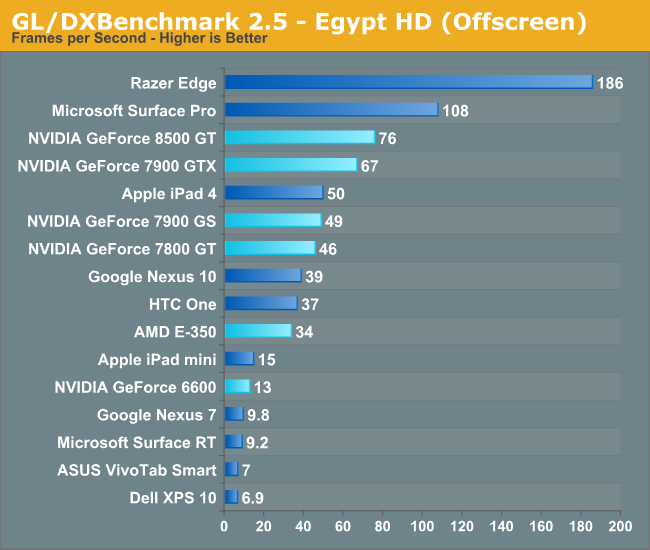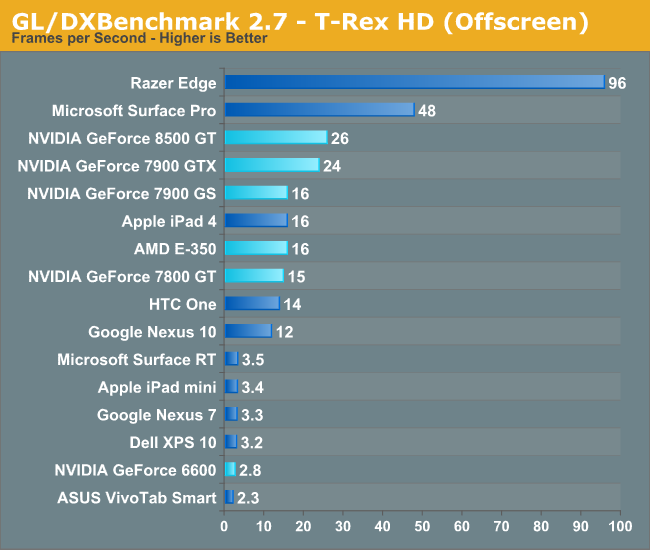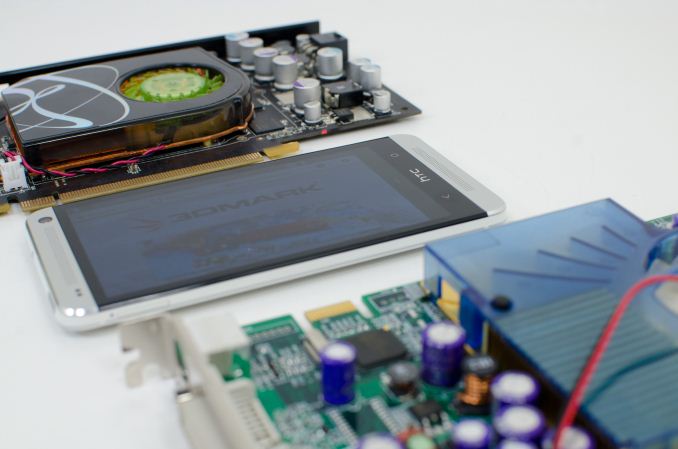The Great Equalizer 3: How Fast is Your Smartphone/Tablet in PC GPU Terms
by Anand Lal Shimpi on April 4, 2013 1:00 AM EST- Posted in
- Tablets
- Smartphones
- Mobile
- GPUs
- SoCs
GL/DXBenchmark 2.7 & Final Words
While the 3DMark tests were all run at 720p, the GL/DXBenchmark results run at roughly 2.25x the pixel count: 1080p. We get a mixture of low level and simulated game benchmarks with GL/DXBenchmark 2.7, the former isn't something 3DMark offers across all platforms today. The game simulation tests are far more strenuous here, which should do a better job of putting all of this in perspective. The other benefit we get from moving to Kishonti's test is the ability to compare to iOS and Windows RT as well. There will be a 3DMark release for both of those platforms this quarter, we just don't have final software yet.
We'll start with the low level tests, beginning with Kishonti's fill rate benchmark:

Looking at raw pixel pushing power, everything post Apple's A5 seems to have displaced NVIDIA's GeForce 6600. NVIDIA's Tegra 3 doesn't appear to be quite up to snuff with the NV4x class of hardware here, despite similarities in the architectures. Both ARM's Mali-T604 (Nexus 10) and ImgTec's PowerVR SGX 554MP4 (iPad 4) do extremely well here. Both deliver higher fill rate than AMD's Radeon HD 6310, and in the case of the iPad 4 are capable to delivering midrange desktop GPU class performance from 2004 - 2005.
Next we'll look at raw triangle throughput. The vertex shader bound test from 3DMark did some funny stuff to the old G7x based architectures, but GL/DXBenchmark 2.7 seems to be a bit kinder:

Here the 8500 GT definitely benefits from its unified architecture as it is able to direct all of its compute resources towards the task at hand, giving it better performance than the 7900 GTX. The G7x and NV4x based architectures unfortunately have limited vertex shader hardware, and suffer as a result. That being said, most of the higher end G7x parts are a bit too much for the current crop of ultra mobile GPUs. The midrange NV4x hardware however isn't. The GeForce 6600 manages to deliver triangle throughput just south of the two Tegra 3 based devices (Surface RT, Nexus 7).
Apple's iPad 4 even delivers better performance here than the Radeon HD 6310 (E-350).
ARM's Mali-T604 doesn't do very well in this test, but none of ARM's Mali architectures have been particularly impressive in the triangle throughput tests.
With the low level tests out of the way, it's time to look at the two game scenes. We'll start with the less complex of the two, Egypt HD:

Now we have what we've been looking for. The iPad 4 is able to deliver similar performance to the GeForce 7900 GS, and 7800 GT, which by extension means it should be able to outperform a 6800 Ultra in this test. The vanilla GeForce 6600 remains faster than NVIDIA's Tegra 3, which is a bit disappointing for that part. The good news is Tegra 4 should be somewhere around high-end NV4x/upper-mid-range G7x performance in this sort of workload. Again we're seeing Intel's HD 4000 do remarkably well here. I do have to caution anyone looking to extrapolate game performance from these charts. At best we know how well these GPUs stack up in these benchmarks, until we get true cross-platform games we can't really be sure of anything.
For our last trick, we'll turn to the insanely heavy T-Rex HD benchmark. This test is supposed to tide the mobile market over until the next wave of OpenGL ES 3.0 based GPUs take over, at which point GL/DXBenchmark 3.0 will step in and keep everyone's ego in check.

T-Rex HD puts the iPad 4 (PowerVR SGX 554MP4) squarely in the class of the 7800 GT and 7900 GS. Note the similarity in performance between the 7800 GT and 7900 GS indicates the relatively independent nature of T-Rex HD when it comes to absurd amounts of memory bandwidth (relatively speaking). Given that all of the ARM platforms south of the iPad 4 line have less than 12.8GB/s of memory bandwidth (and those are the platforms these benchmarks were designed for), a lack of appreciation for the 256-bit memory interfaces on some of the discrete cards is understandable. Here the 7900 GTX shows a 50% increase in performance over the 7900 GS. Given the 62.5% advantage the GTX holds in raw pixel shader performance, the advantage makes sense.
The 8500 GT's leading performance here is likely due to a combination of factors. Newer drivers, a unified shader architecture that lines up better with what the benchmark is optimized to run on, etc... It's still remarkable how well the iPad 4's A6X SoC does here as well as Qualcomm's Snapdragon 600/Adreno 320. The latter is even more impressive given that it's constrained to the power envelope of a large smartphone and not a tablet. The fact that we're this close with such portable hardware is seriously amazing.
At the end of the day I'd say it's safe to assume the current crop of high-end ultra mobile devices can deliver GPU performance similar to that of mid to high-end GPUs from 2006. The caveat there is that we have to be talking about performance in workloads that don't have the same memory bandwidth demands as the games from that same era. While compute power has definitely kept up (as has memory capacity), memory bandwidth is no where near as good as it was on even low end to mainstream cards from that time period. For these ultra mobile devices to really shine as gaming devices, it will take a combination of further increasing compute as well as significantly enhancing memory bandwidth. Apple (and now companies like Samsung as well) has been steadily increasing memory bandwidth on its mobile SoCs for the past few generations, but it will need to do more. I suspect the mobile SoC vendors will take a page from the console folks and/or Intel and begin looking at embedded/stacked DRAM options over the coming years to address this problem.











128 Comments
View All Comments
SPBHM - Thursday, April 4, 2013 - link
Interesting stuff, the HD 4000 completely destroys the 7900GTX,considering the Playstation 3 uses a cripled G70 based GPU, is fantastic the results they can achieve under a higher optimized platform...
also, it would have been interesting to see something from ATI, a x1900 or x1950. I think itwould represent better the early 2006 GPUs
milli - Thursday, April 4, 2013 - link
Yeah agree. I've seen recent benchmarks of a X1950 and it aged much better than the 7900GTX.Spunjji - Friday, April 5, 2013 - link
Definitely, it had a much more forward-looking shader arrangement; tomorrow's performance cannot sell today's GPU though and I'm not sure AMD have fully learned from that yet.Th-z - Thursday, April 4, 2013 - link
I'll take these numbers with a grain of salt, 7900 GTX still has the memory bandwidth advantage, about 2x as much, maybe in actual games or certain situations it's faster. Perhaps Anand can do a retro discrete vs today's iGPU review just for the trend, it could be fun as well :)Wilco1 - Thursday, April 4, 2013 - link
Anand, what exactly makes you claim: "Given that most of the ARM based CPU competitors tend to be a bit slower than Atom"? On the CPU bound physics test the Z-2760 scores way lower than any of the Cortex-A9, A15 and Snapdragon devices (A15 is more than 5 times as fast core for core despite the Atom running at a higher frequency). Even on Sunspider score Atom scores half that of an A15. I am confused, it's not faster on single threaded CPU tasks, not on multi-threaded CPU tasks, and clearly one of the worst on GPU tasks. So where exactly is Atom faster? Or are you talking about the next generation Atoms which aren't out yet???tech4real - Thursday, April 4, 2013 - link
It's fairly odd to see such a big gap between atom and A9/A15 in a supposedly CPU bound test. However the score powerarmour showed several posts earlier on an atom330/ion system seems to give us some good explanation.The physics core 7951 and 25.2 FPS of his atom330/ion system is pretty in line with what the atom cpu expectation is, faster than a9, a bit slower than a15. So i would guess that the extremely low z2760 score is likely due to its driver implementation, and is not truly exercising CPU for that platform.
Wilco1 - Thursday, April 4, 2013 - link
It may be a driver issue, however it doesn't mean that with better drivers a Z-2760 would be capable of achieving that same score. The Ion Atom uses a lot more power, not just the CPU, but also the separate higher-end GPU and chipset. Besides driver differences, a possibility is that the Z-2760 is thermally throttled to stay within a much lower TDP.tech4real - Friday, April 5, 2013 - link
the scale of the drop does not look like a typical thermal throttle, so I would lean towards the "driver screw up" theory, particularly considering intel's poor track record on PowerVR driver support. It would be interesting to see someone digging a bit deeper into this.islade - Thursday, April 4, 2013 - link
I'd love to see an iPad 3 included in this results. I'm sure many readers have iPad 3's and couldn't justify upgrading to the 4, so I'd love to see where we fit in with all this :)tipoo - Sunday, April 7, 2013 - link
CPU wise you'd be the exact same as the iPad 2, Mini, and just slightly above the 4S. GPU wise you'd be like the 5.